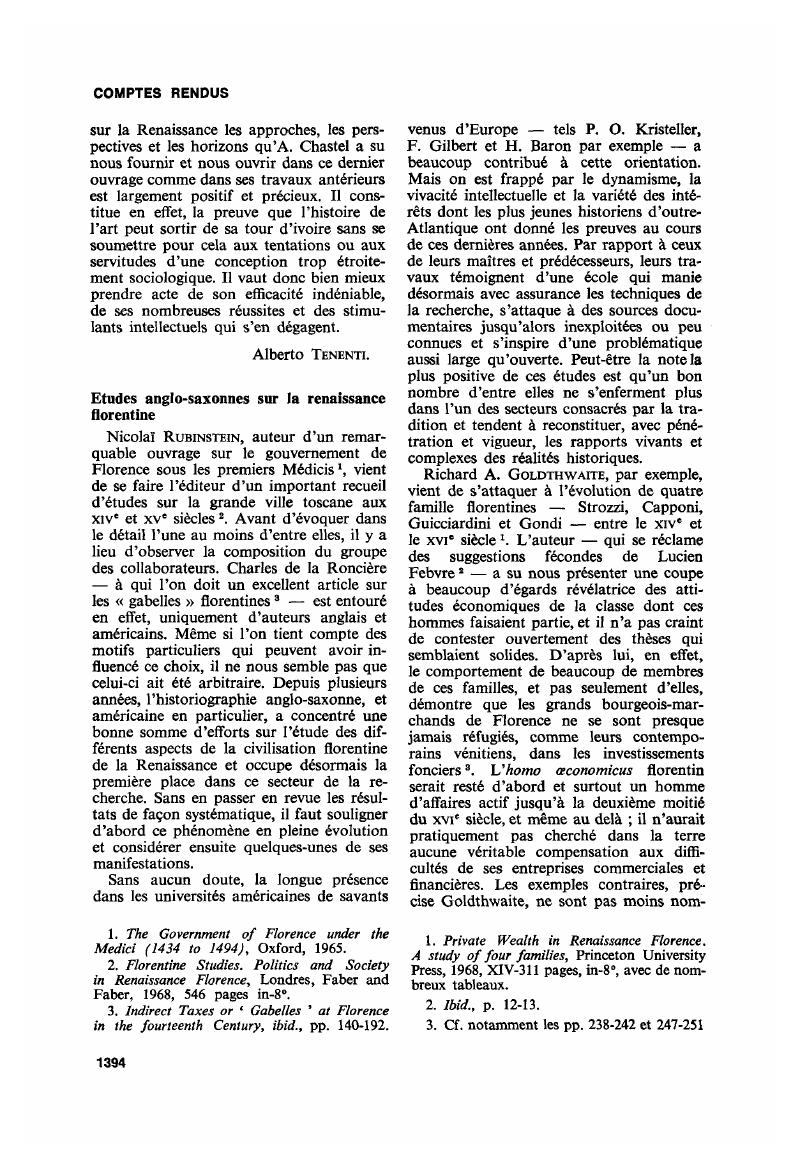No CrossRef data available.
Published online by Cambridge University Press: 25 May 2018

page 1394 note 1. The Government of Florence under the Medici (1434 to 1494), Oxford, 1965.
page 1394 note 2. Florentine Studies. Politics and Society in Renaissance Florence, Londres, Faber and Faber, 1968, 546 pages in-8°.
page 1394 note 3. Indirect Taxes or ‘ Gabelles ’ at Florence in the fourteenth Century, ibid., pp. 140-192.
page 1394 note 1. Private Wealth in Renaissance Florence. A study of four families, Princeton University Press, 1968, XIV-311 pages, in-8°, avec de nombreux tableaux.
page 1394 note 2. Ibid., p. 12-13.
page 1394 note 3. Cf. notamment les pp. 238-242 et 247-251.
page 1395 note 1. Voir en particulier les pp. 249-250.
page 1395 note 2. Ibid., pp. 253-262.
page 1395 note 3. Lawyers and Statecraft in Renaissance Florence, Princeton University Press, 1968, XII-531 pages in-8°.
page 1395 note 1. Ibid., pp. 5-6.
page 1395 note 2. Ibid., pp. 394-396.
page 1395 note 3. Ibid., pp. 400-401.
page 1395 note 4. « Hence it was the redistribution of the executive power which anabled the ruling families, by their continuous contact with the major offices, to realize a closer identity with the state. Wherefore it follows that the redistribution signified an entranchment, a reaffirmation of oligarchy, not a departure from it », ibid., p. 401 ; cf. également p. 391.
page 1396 note 1. Ibid., p. 414.
page 1396 note 2. Ibid., p. 391 et 430-431.
page 1396 note 3. Ibid., p. 402.
page 1396 note 1. La crisi del primo Rinascimento. Umanesimo civile e libertà repubblicana in un'età di classicismo e di tirannide, traduit par Renzo Pecchioli, Florence, Sansoni, 1970, XLII-525 pages, in-8°.
page 1397 note 1. Dans la présentation que Hans Baron a rédigée dernièrement pour l'édition italienne de son ouvrage, il évoque ce type d'objection et il ébauche une réponse fort décevante. Il affirme que les limites à l'égalité civile et sociale des Florentins ne différaient pas beaucoup de celles qu'on rencontrait dans les autres villesétats de la Péninsule. Comme si pareilles limites étaient quelque chose de figé et d'établi à Florence à cette époque. Une véritable transformation était en cours dans l'assiette intérieure de la ville et, qui est plus, les humanistes dont Baron nous parle ne l'ont pas du tout ignorée.
page 1397 note 1. « We hâve also found that Humanism was not the only créative force about 1400 : some of the major innovations were first made by citizens who had been but slightly touched by Humanism — men like Cino Rinuccini and Gregorio Dati » ; cf. The Crisis…, cit., Princeton, 1966, pp. 447-448.
page 1398 note 1. Ibid., pp. 430-432 et 560-561.
page 1398 note 1. The Social World of the Florentine Humanists, Princeton University Press, 1963, 419 pages in-8°.
page 1398 note 2. Renaissance Florence, New York-Londres-Sidney-Toronto, John Wiley and Sons, 1969, XTV-306 pages.
page 1398 note 3. Florentine Folitics and Society, 1343-1378, Princeton, 1962.
page 1398 note 4. The Ciompi Révolution, dans Florentine Studies…, cit., pp. 314-356.
page 1399 note 1. Renaissance Florence, cit., pp. 169-170.
page 1399 note 2. Ibid., p. 237.
page 1399 note 3. « The Florentine Territorial State and Civic Humanism in the Early Renaissance», dans Florentine Studies, cit., pp. 109-139.